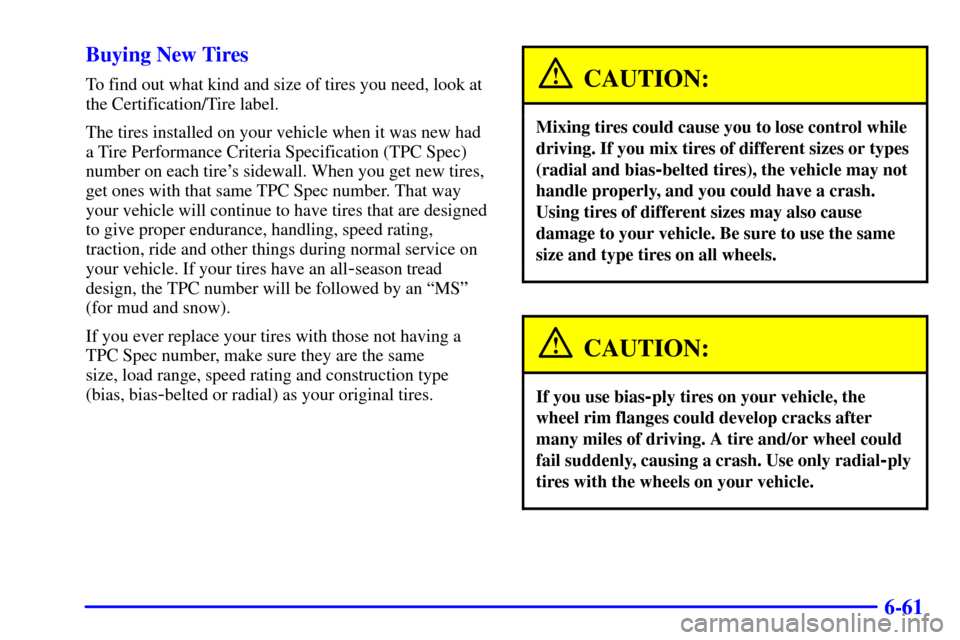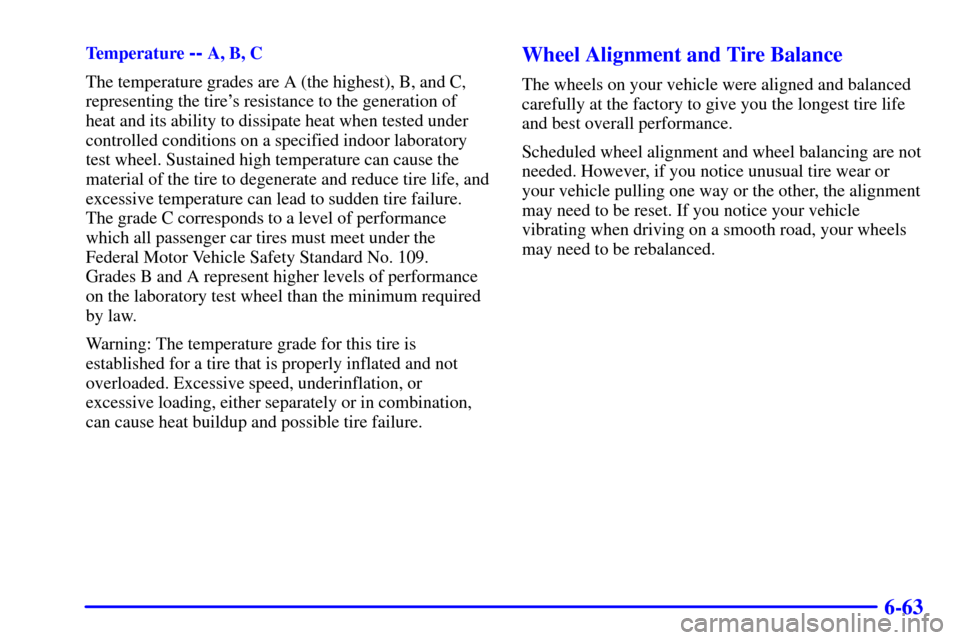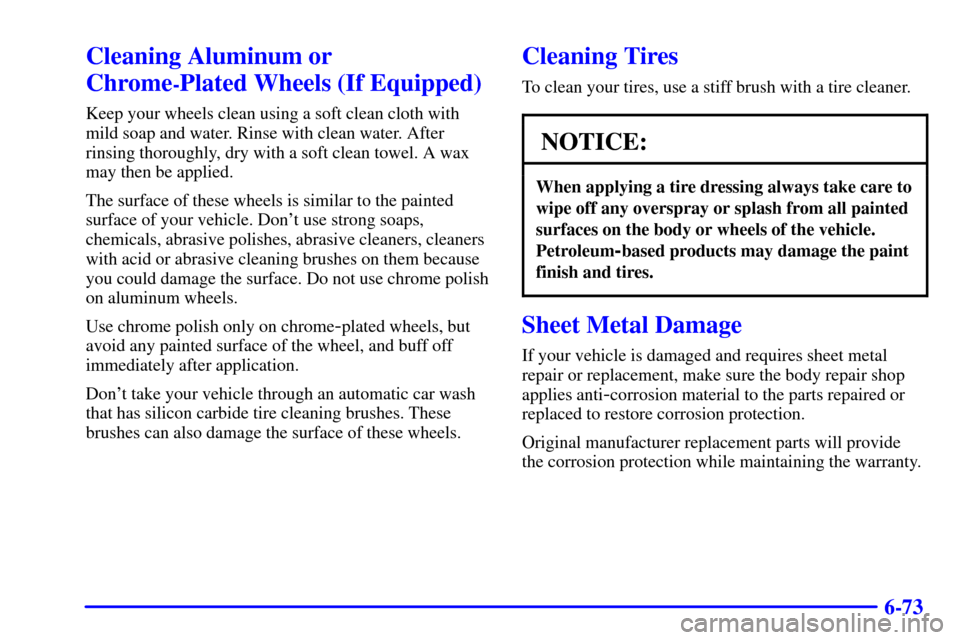Page 426 of 497

6-61 Buying New Tires
To find out what kind and size of tires you need, look at
the Certification/Tire label.
The tires installed on your vehicle when it was new had
a Tire Performance Criteria Specification (TPC Spec)
number on each tire's sidewall. When you get new tires,
get ones with that same TPC Spec number. That way
your vehicle will continue to have tires that are designed
to give proper endurance, handling, speed rating,
traction, ride and other things during normal service on
your vehicle. If your tires have an all
-season tread
design, the TPC number will be followed by an ªMSº
(for mud and snow).
If you ever replace your tires with those not having a
TPC Spec number, make sure they are the same
size, load range, speed rating and construction type
(bias, bias
-belted or radial) as your original tires.
CAUTION:
Mixing tires could cause you to lose control while
driving. If you mix tires of different sizes or types
(radial and bias
-belted tires), the vehicle may not
handle properly, and you could have a crash.
Using tires of different sizes may also cause
damage to your vehicle. Be sure to use the same
size and type tires on all wheels.
CAUTION:
If you use bias-ply tires on your vehicle, the
wheel rim flanges could develop cracks after
many miles of driving. A tire and/or wheel could
fail suddenly, causing a crash. Use only radial
-ply
tires with the wheels on your vehicle.
Page 428 of 497

6-63
Temperature -- A, B, C
The temperature grades are A (the highest), B, and C,
representing the tire's resistance to the generation of
heat and its ability to dissipate heat when tested under
controlled conditions on a specified indoor laboratory
test wheel. Sustained high temperature can cause the
material of the tire to degenerate and reduce tire life, and
excessive temperature can lead to sudden tire failure.
The grade C corresponds to a level of performance
which all passenger car tires must meet under the
Federal Motor Vehicle Safety Standard No. 109.
Grades B and A represent higher levels of performance
on the laboratory test wheel than the minimum required
by law.
Warning: The temperature grade for this tire is
established for a tire that is properly inflated and not
overloaded. Excessive speed, underinflation, or
excessive loading, either separately or in combination,
can cause heat buildup and possible tire failure.Wheel Alignment and Tire Balance
The wheels on your vehicle were aligned and balanced
carefully at the factory to give you the longest tire life
and best overall performance.
Scheduled wheel alignment and wheel balancing are not
needed. However, if you notice unusual tire wear or
your vehicle pulling one way or the other, the alignment
may need to be reset. If you notice your vehicle
vibrating when driving on a smooth road, your wheels
may need to be rebalanced.
Page 429 of 497

6-64 Wheel Replacement
Replace any wheel that is bent, cracked, or badly rusted
or corroded. If wheel nuts keep coming loose, the wheel,
wheel bolts and wheel nuts should be replaced. If the
wheel leaks air, replace it (except some aluminum
wheels, which can sometimes be repaired). See your
dealer if any of these conditions exist.
Your dealer will know the kind of wheel you need.
Each new wheel should have the same load
-carrying
capacity, diameter, width, offset and be mounted the
same way as the one it replaces.
If you need to replace any of your wheels, wheel bolts
or wheel nuts, replace them only with new GM original
equipment parts. This way, you will be sure to have the
right wheel, wheel bolts and wheel nuts for your vehicle.
CAUTION:
Using the wrong replacement wheels, wheel bolts
or wheel nuts on your vehicle can be dangerous.
It could affect the braking and handling of your
vehicle, make your tires lose air and make you
lose control. You could have a collision in which
you or others could be injured. Always use
the correct wheel, wheel bolts and wheel nuts
for replacement.
Page 430 of 497
6-65
NOTICE:
The wrong wheel can also cause problems with
bearing life, brake cooling, speedometer or
odometer calibration, headlamp aim, bumper
height, vehicle ground clearance and tire or tire
chain clearance to the body and chassis.
Whenever a wheel, wheel bolt or wheel nut is replaced
on a dual wheel setup, check the wheel nut torque after
100, 1,000 and 6,000 miles (160, 1 600 and 10 000 km)
of driving. For proper torque, see ªWheel Nut Torqueº
in the Index.
See ªChanging a Flat Tireº in the Index for
more information.Used Replacement Wheels
CAUTION:
Putting a used wheel on your vehicle is
dangerous. You can't know how it's been used or
how far it's been driven. It could fail suddenly
and cause a crash. If you have to replace a wheel,
use a new GM original equipment wheel.
Page 431 of 497

6-66 Tire Chains
CAUTION:
If your vehicle has dual wheels or P265/75R16 or
LT265/75R16 size tires, don't use tire chains. They
can damage your vehicle because there's not
enough clearance. Tire chains used on a vehicle
without the proper amount of clearance can cause
damage to the brakes, suspension or other vehicle
parts. The area damaged by the tire chains could
cause you to lose control of your vehicle and you
or others may be injured in a crash.
Use another type of traction device only if its
manufacturer recommends it for use on your
vehicle and tire size combination and road
conditions. Follow that manufacturer's
instructions. To help avoid damage to your
vehicle, drive slowly, readjust or remove the
device if it's contacting your vehicle, and don't
spin your wheels.
If you do find traction devices that will fit, install
them on the rear tires.
NOTICE:
If your vehicle does not have dual wheels and is
equipped with a tire size other than P265/75R16
or LT265/75R16, use tire chains only where legal
and only when you must. Use chains that are the
proper size for your tires. Install them on the
tires of the rear axle.
Don't use chains on the tires of the front axle.
Tighten them as tightly as possible with the ends
securely fastened. Drive slowly and follow the
chain manufacturer's instructions. If you can
hear the chains contacting your vehicle, stop
and retighten them. If the contact continues,
slow down until it stops. Driving too fast or
spinning the wheels with chains on will damage
your vehicle.
Page 438 of 497

6-73
Cleaning Aluminum or
Chrome
-Plated Wheels (If Equipped)
Keep your wheels clean using a soft clean cloth with
mild soap and water. Rinse with clean water. After
rinsing thoroughly, dry with a soft clean towel. A wax
may then be applied.
The surface of these wheels is similar to the painted
surface of your vehicle. Don't use strong soaps,
chemicals, abrasive polishes, abrasive cleaners, cleaners
with acid or abrasive cleaning brushes on them because
you could damage the surface. Do not use chrome polish
on aluminum wheels.
Use chrome polish only on chrome
-plated wheels, but
avoid any painted surface of the wheel, and buff off
immediately after application.
Don't take your vehicle through an automatic car wash
that has silicon carbide tire cleaning brushes. These
brushes can also damage the surface of these wheels.
Cleaning Tires
To clean your tires, use a stiff brush with a tire cleaner.
NOTICE:
When applying a tire dressing always take care to
wipe off any overspray or splash from all painted
surfaces on the body or wheels of the vehicle.
Petroleum
-based products may damage the paint
finish and tires.
Sheet Metal Damage
If your vehicle is damaged and requires sheet metal
repair or replacement, make sure the body repair shop
applies anti
-corrosion material to the parts repaired or
replaced to restore corrosion protection.
Original manufacturer replacement parts will provide
the corrosion protection while maintaining the warranty.
Page 444 of 497
6-79
Fuse Usage
CRUISE Cruise Control, Instrument
Panel Cluster
4WD Four
-Wheel Drive System,
Auxiliary Battery
TURN Exterior Lamps, Turn Signals,
Hazard Lamps
RR WIPER Not Used
WS WPR Windshield Wipers
SEO IGN Special Equipment Option,
Ignition, Manual Selectable Ride
ILLUM Interior Lamps
IGN 1 Ignition, Instrument Panel
SEO ACCY Special Equipment Option
Accessory, Cellular Telephone
L BODY Retained Accessory Power Relay
CRANK Starting SystemFuse Usage
AIR BAG Air Bag
MIR/LOCK Power Mirrors, Power Door Locks
SEAT Power Seat Circuit Breaker
DR LOCK Power Door Locks
RAP #1 Retained Accessory Power Relay
LOCK Power Door Locks
INT PRK Interior Lamps
UNLOCK Power Door Locks
DRV UNLOCK Power Door Lock Relay
L DOOR Power Door Lock Relay
PWR WDO Power Window Circuit Breaker
RDO 1 Audio System
RAP #2 Not Used
LOCK Power Door Lock Relay
UNLOCK Power Door Lock Relay
Page 451 of 497
6-86
Capacities and Specifications
Please refer to ªRecommended Fluids and Lubricantsº in the Index for more information. All capacities are
approximate. When adding see the refrigerant charge label under the hood for charge capacity information and
requirements.
Engine Type VIN Code Spark Plug Gap
VORTEC 4300 V6 W 0.060 inches (1.52 mm)
VORTEC 4800 V8 V 0.060 inches (1.52 mm)
VORTEC 5300 V8 T 0.060 inches (1.52 mm)
VORTEC 6000 V8 U 0.060 inches (1.52 mm)
VORTEC 6600 V8 1 0.060 inches (1.52 mm)
VORTEC 8100 V8 G 0.060 inches (1.52 mm)
Wheels and Tires
Model Description Torque
C/K 1500 & C/K 2500 6 bolts (14 mm)
140 lb
-ft (190 N´m)
C/K 3500 8 bolts (14 mm)
140 lb
-ft (190 N´m)
Tire Pressure See the Certification/Tire label on the rear edge of the driver's door
or the incomplete vehicle document in the cab.